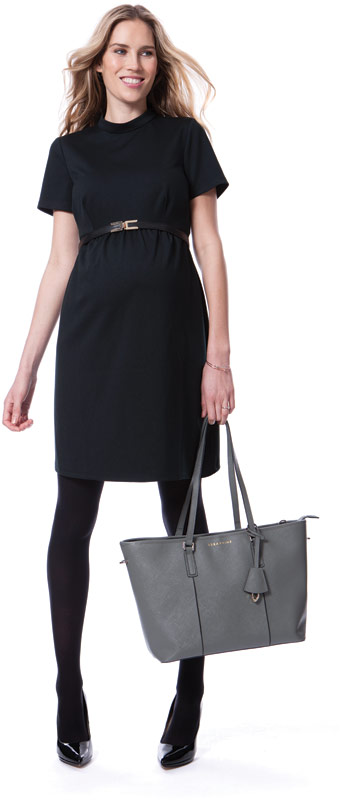Pregnant women seek style and versatility.

Black dress by Séraphine
Take a hike, bows and empire waists: Today’s expectant women want fitted, stylish, versatile clothing they can wear long after giving birth. Taking cues from photographs they see of Kim Kardashian wearing an ultra sheer Givenchy lace dress at the height of her baby bump days with Saint or the Duchess of Cambridge wearing a fuchsia wrap dress by Séraphine post the birth of Prince George, maternity customers don’t want to simply cover up their bump, they want to enhance it.
“You don’t need to dress like the baby or a grandmother when you’re pregnant,” emphasizes Austin Ross, web and PR manager for Mom’s the Word with three stores in Los Angeles, Palo Alto, Calif., and San Francisco. “So much of maternity is very baby-ish or matronly. It’s just bad. We don’t believe in that.”
The past five years have been a struggle for many maternity companies. According to the industry market research firm IBISWorld, annual growth from 2011 to 2016 weighed in at a tepid 0.2 percent. Maternity accounts for about $2 billion in revenue each year. Birth rates have been flat and demand for maternity has not risen significantly to offset the losses brought on by the recession, the report noted. Add to that many families’ delaying decisions to have children and competition from online retailers, as well as mass discount stores getting into the action. The report states brick-and-mortar can expect these type of challenges through 2021. Beyond that, we start to see some optimism. The economic recovery will continue, the report states, and with it consumer sentiment and disposal income will improve and support growth in the future.
In the meantime, stores and manufacturers have shifted their strategies to accommodate the demands of today’s customer—older ,and who generally has more disposable income thanks to her or her spouse’s stage in career.
Séraphine, the maternity clothing designer and retailer favored by the Duchess (she was famously photographed in that fuchsia wrap dress which prompted it to sell out in a matter of hours) has been in the U.S. for three-and-a-half years with two stores in New York and has been received here with enthusiasm, according to Creative Director and Founder Cecile Reinaud. Séraphine generally targets trendy, classic and sporty lifestyles.
The London-based company plans to roll out 10 more stores in the U.S. within the next three years, anticipating locations in Connecticut, Los Angeles and San Francisco. When asked what’s behind her company’s success, Reinaud says celebrities are indeed paving the way. “The whole notion of pregnancy; women dream of wanting to look good and to look nice in pictures,” she explains. “It’s a very positive trend.”
One new trend Reinaud has noticed is that celebrities have been pushing nursing. Gisele Bundchen, in particular, has been very vocal about the pros of nursing, including health and bonding opportunities. To that end, the company has been creating various designs that enable moms to discreetly feed their babies.

Camel sweater by Séraphine
Isreal Vahaba, founder and vice president of Izzy Maternity in Atlanta, has made inroads thanks to bumping up the level of style in his assortment. He remembers a time when maternity clothing silhouettes were either empire, bubble or A-line. “Today, it’s a whole new ballgame,” he says. “They want whatever is in ready-to-wear with a little more room in the bust and the tummy. They want whatever’s in fashion—the color, fabric and details.” Vahaba says his inventory—an average sale is $128—is so fashion-forward, he attracts non-pregnant customers on a regular basis. “Our customer is professional or married to someone that’s wealthy. Our designer jeans and tops are $200, our gowns are $500 and, yesterday, I sold a gown for $900.”
Over the years, Vahaba decided to close down two locations to focus on one and upgrade the store’s customer service. Lamenting the glory days of maternity gone by—“I used to be in the business with big fish, now the aquarium is empty”—he nevertheless found a way to stay relevant. “The customers like me,” he says.
Convincing customers to make an investment in maternity comes down to the garment’s multi-end use. In other words, the item has to have more life than just nine months and women want to envision wearing it long after their bumps go down. “We don’t believe in throwaway clothes,” says Ross, who also notes that non-pregnant women shop his stores. “The most important thing is that you have a pair of maternity pants.” Mom’s the Word carries J. Brand and Paige Denim jeans in exactly the same silhouettes that non-pregnant women wear, except for the added stretch and jersey panels. Other than that, he’s found success with rompers, dresses and tees. “While you’re pregnant, we think you should continue on with your persona style,” he adds. “And the days of tons of fabric is over. Even people who like to wear flowy things, they’re not lost in yards of fabric.”
In addition, pregnant women are turning to non-traditional collections likeHolicow, which manufacturers 100 percent organic cotton one-size-fits-all, Indian hand-blocked print jumpers, rompers and tunics in Los Angeles. “Our line wasn’t necessarily maternity,” says Nancy Davis, the company’s partner and director of distribution and sales. “But women began turning to us for it because it’s so loose-fitting.” Pieces double as other styles as well: For example, harem pants can be pulled up over the bust and worn as a capri jumper and vice versa. “You can wear it throughout your whole pregnancy and even afterwards when you’re not,” she adds. “It’s a good investment. It’s not something that you’re going to spend $80 on and put it in a box until you have another child.”



Leave a Comment: